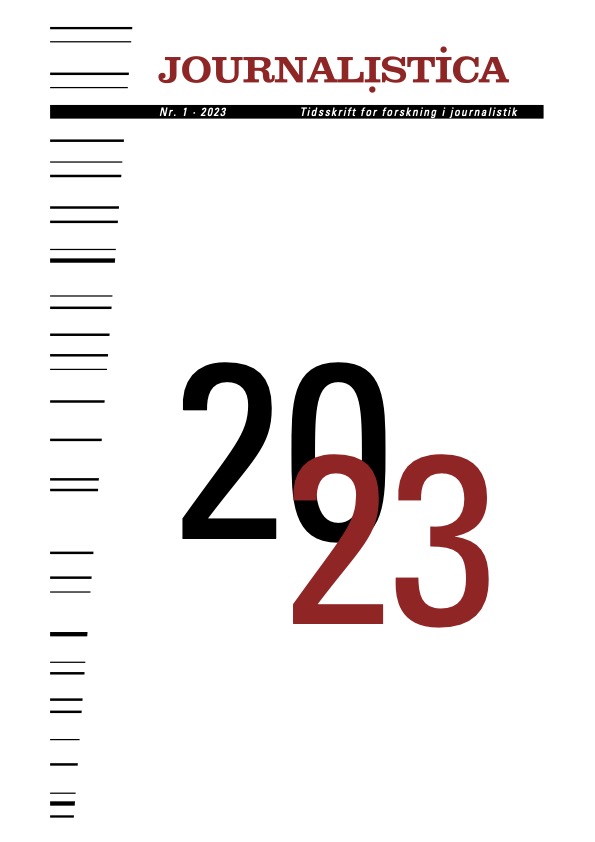Bringing it to the classroom
An empirical study of using a hands-on model for creating digital storytelling
DOI:
https://doi.org/10.7146/journalistica.v17i1.136864Nøgleord:
digital storytelling, digital journalism, action research, digital story model, narrative journalismResumé
The article introduces the Digital Story Model. The model is made with the ambition to improve and enrich digital stories done by journalism students, professional journalists and other kinds of digital storytellers . In the study we adopt an action-based research approach and test the model in an international classroom setting with 85 journalism students representing 35 countries. The findings of students' experiences with applying the model point to a number of strengths and shortcomings. Strengths include the model as a structuring and planning tool, as a way to benefit creativity, as a shared language in an international group and as an assistance in considering the potential story modalities. Shortcomings include the model preventing creativity and creating standardized stories, the model being mostly beneficial for inexperienced reporters and being too linear. The study concludes that there is a significant usefulness of the model when it comes to enriching digital storytelling but also a need to revise the model further and to alter the way it is presented in the classroom.
Referencer
Andreasen, S. & Giebner, F. (2021). Webdoks: Store historier til små skærme. In L. Rimestad og J. M. Hartley (eds.) Den undersøgende journalistiks metoder (pp. 317-337). Samfundslitteratur.
Dowling, D. & Vogan, T. (2015). Can we “snowfall” this? Digital long-form and the race for the tablet market. Digital Journalism, 3(2), 209-224.
Dowling, D. (2019). Literary Journalism in the Digital Age. In W. Dow & R. Maguire (eds.) The Routledge Companion to American Literary Journalism (pp. 529-542). Routledge.
Dunham, R.S. (2020). Multimedia Reporting. Springer. https://doi.org/10.1007/978-981-13-6163-0_12
Fendt, J. and Kaminska-Labbé, R. (2011.) Relevance and Creativity through Design-driven Action Research: Introducing Pragmatic Adequacy. European Management Journal 29 (3): 217–233. doi:10.1016/j.emj.2010.10.004.
Grabowicz, P., Hernandez, R., & Rue, J. (2014, March 9). Taxonomy of digital story packages. kdmcBerkeley. Retrieved from: https://multimedia.journalism.berkeley.edu/tutorials/taxonomy-digital-story-packages
Greenwood, D. J., & Levin, M. (2006). Introduction to action research: Social research for social change. SAGE publications.
Grubenmann, S. (2019). Action Research: Collaborative research for the improvement of digital journalism practice. Digital Journa-lism, 4:1, 160-176. https://doi.org/10.1080/21670811.2015.1093274
Hernandez, R.K. & Rue, J. (2016). The Principles of Multimedia Jour-nalism: Packaging Digital News. Routledge.
Hiippala, T. (2016). The Multimodality of Digital Longform Journal-ism. Digital Journalism, 5(4), 420-442.
Jacobson, S., Marino, J. & Gutsche, R. E. (2015). The digital animation of literary journalism. Journalism, 17(4), 527–546.
Meier, K., & Schützeneder, J. (2019). Bridging the Gaps: Transfer Be-tween Scholarly Research and Newsrooms in Journalism Educa-tion—Toward an Evidence-Based Practice in an Age of Post-Truth and State of Flux. Journalism & Mass Communication Educator, 74(2), 199–211. https://doi.org/10.1177/1077695819830021
Moestrup, Steffen. (2022) Det Digitale Jeg: Jeg bliver til i en strøm af nuller og ettaller, som du kan klikke på. In: Hvad laver JEG her? En lærebog om at bruge sig selv i journalistikken. København: Sam-fundslitteratur.
Pavlik, J.V and Pavlik, J.O (2017) Understanding Quality in Digital Storytelling: A Theoretically Based Analysis of the Interactive Documentary. In Friedrichsen, M. and Y. Kamalipour (eds.). Digital Transformation in Journalism and News Media: Media Manage-ment, Media Convergence and Globalization (pp. 381-396). Spring-er International Publishing.
Planer R, Godulla A, Seibert D, Pietsch P. (2022) Journalistic Quality Criteria under the Magnifying Glass: A Content Analysis of the Winning Stories of World Press Photo Foundation’s Digital Story-telling Contest. Journalism and Media. 2022; 3(4):594-614. https://doi.org/10.3390/journalmedia3040040
Reason, P., and H. Bradbury-Huang. 2007. The SAGE Handbook of Action Research: Participative Inquiry and Practice. Sage Publica-tions.
Schudson, M. (2011). The sociology of news. W.W. Norton & Company.
Van Krieken, K. (2018). Multimedia Storytelling in Journalism: Ex-ploring Narrative Techniques in Snow Fall. Information, 9, 123, doi:10.3390/info9050123
Downloads
Yderligere filer
Publiceret
Citation/Eksport
Nummer
Sektion
Licens
Copyright (c) 2023 Steffen Moestrup, Karsten Vestergaard

Dette værk er under følgende licens Creative Commons Navngivelse (by).
Forfattere, der publicerer deres værker via dette tidsskrift, accepterer følgende vilkår:
- Forfattere bevarer deres ophavsret og giver tidsskriftet ret til første publicering, samtidigt med at værket er omfattet af en Creative Commons Attribution-licens, der giver andre ret til at dele værket med en anerkendelse af værkets forfatter og første publicering i nærværende tidsskrift.
- Forfattere kan indgå flere separate kontraktlige aftaler om ikke-eksklusiv distribution af tidsskriftets publicerede version af værket (f.eks. sende det til et institutionslager eller udgive det i en bog), med en anerkendelse af værkets første publicering i nærværende tidsskrift.
- Forfattere har ret til og opfordres til at publicere deres værker online (f.eks. i institutionslagre eller på deres websted) forud for og under manuskriptprocessen, da dette kan føre til produktive udvekslinger, samt tidligere og større citater fra publicerede værker (se The Effect of Open Access).





